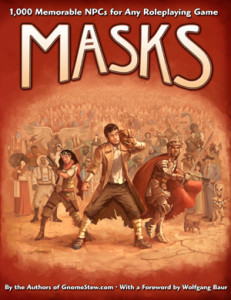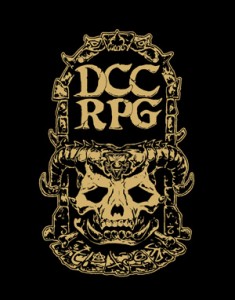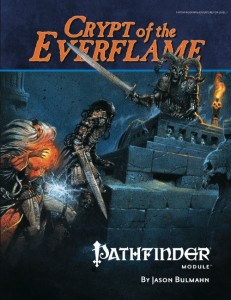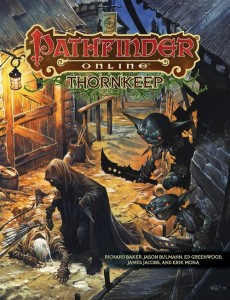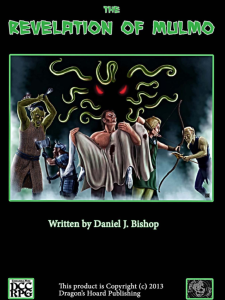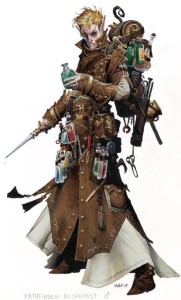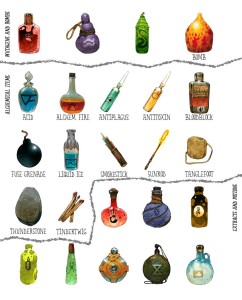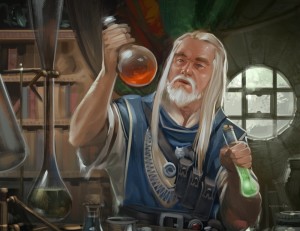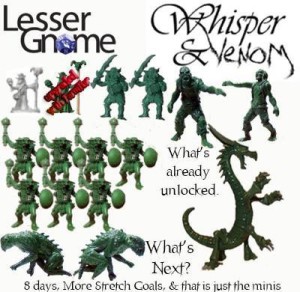 Over on the Kickstarter site there is a particularly interesting project coming into the final stretch. The project is Whisper & Venom from Lesser Gnome. Whisper & Venom is an RPG Adventure boxed set, complete with 28mm metal miniatures. The boxed set will contain a guide to Whisper Vale, an adventure sourcebook, a full color hand-drawn, two-sided poster map by Alyssa Faden, a set of polyhedral dice, more and more minis nearly everyday – all in a 12”x9” box! The boxed set will also include cover art from Jeff Dee and interior art from Lloyd Metcalf.
Over on the Kickstarter site there is a particularly interesting project coming into the final stretch. The project is Whisper & Venom from Lesser Gnome. Whisper & Venom is an RPG Adventure boxed set, complete with 28mm metal miniatures. The boxed set will contain a guide to Whisper Vale, an adventure sourcebook, a full color hand-drawn, two-sided poster map by Alyssa Faden, a set of polyhedral dice, more and more minis nearly everyday – all in a 12”x9” box! The boxed set will also include cover art from Jeff Dee and interior art from Lloyd Metcalf.
Whisper & Venom has well exceeded its initial funding goal of $5000 and many new miniatures have been added. The most recent update to the project talks about more stretch goals and if funding surpasses $20,000 support for Pathfinder proper!
Earlier this week The Iron Tavern caught up with Zach Glazar, the head gnome behind Lesser Gnome. He graciously took the time to answer several questions to tell The Iron Tavern a little more about the Whisper & Venom project and where they are headed in the final week of the Kickstarter.
Interview With Zach Glazar
Questions from The Iron Tavern are bolded and prefaced with IT and Zach’s responses are prefaced with ZG. The art used with this post are all examples from the boxed set and used with Zach’s permission. Enjoy!
IT: Obviously the big thing on your plate right now is the Lesser Gnome Kickstarter for Whisper & Venom. Can you tell us a little more about that?
ZG: Of course I can and I am delighted to do so.
Whisper & Venom is my attempt to bring a truly deluxe adventure boxed-set to the small press market that is written in tribute to the ones I was so obsessed over in my, now long ago, youth. I had always wanted an adventure module that came with everything. Every extra that I could never find, let alone afford, all in one box that had amazing art, poster maps with stunning cartography and all the unique figurines included in the text.
I was never able to understand why such an obviously flawless idea wasn’t the standard way every module came. As an adult fascinated by economics I understand completely why, but I still wanted it.
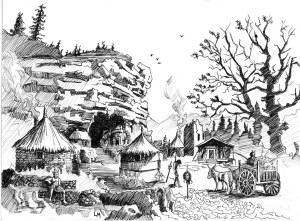 Well with 11 days to go I am pretty close. The cover of the box (and main booklet) is a commissioned acrylic painting by Jeff Dee, the vast majority of interior illustrations were done by Lloyd MetCalf in pen and ink, the poster map is nearly completed by Alyssa Faden and four different and well-known sculptors are working on (and have largely completed) a small army of adversaries for the box…some of which have been selected by backers of the project via a surveys.
Well with 11 days to go I am pretty close. The cover of the box (and main booklet) is a commissioned acrylic painting by Jeff Dee, the vast majority of interior illustrations were done by Lloyd MetCalf in pen and ink, the poster map is nearly completed by Alyssa Faden and four different and well-known sculptors are working on (and have largely completed) a small army of adversaries for the box…some of which have been selected by backers of the project via a surveys.
It took a great deal of effort to get to this point but it also took a great deal of money. Having brought all these elements at this state of completion during the funding period would, of course, have been impossible without significant investment. I wanted the best people available to me to be involved in Whisper & Venom and it was my number one priority that they be paid in full the instant I received an invoice.
Oddly, I now find that having taken that level of risk has added value to the project beyond the value of simply having top artists. It is very much an indicator of how serious I am in delivery which has become a major concern for a majority of the backers I interact with on Kickstarter.
Your question stated that the Kickstarter for Whisper & Venom was the big thing on my plate. I will start by saying that you are almost correct. The truth is it is the only thing on my plate and has been for at least 3 months and will not end until at least December. This whole experience has been one of the best of my life, which is a good thing, because it is also been my whole life.
Long planning and financial investment has gone into Whisper & Venom and it is my top priority. I am a very lucky gnome in that personal flexibility with career and family choices has allowed this focus. Anyone who reads this that has done a big Kickstarter project while having full-time family and occupational responsibilities is elevated to near superhuman status in my eyes.
IT: I have seen you describe Whisper & Venom a boutique adventure boxed set. Tell me more about that description for this product.
ZG: Well I enjoyed the early development of Whisper & Venom a great deal and wanted to be able to do the whole process over again. I certainly did not think I would make any money out of it (I still don’t, though defraying my costs would be a plus). I just wanted to make a product that others might want to buy. At the time ‘others’ consisted of literally dozens of potential customers (this was before Kickstarter).
 Small press publishing for any hobby market is already hard to maintain as a going concern. The barrier to entry is pretty low and there are some great products available for free. So with so many products (some really great, others were great by virtue of being free) it was hard to imagine having anyone even noticing a product in a such a crowded space. This is doubly true when price sensitivity is such that a 20 page supplement might look great and be priced $1 and still be considered too expensive.
Small press publishing for any hobby market is already hard to maintain as a going concern. The barrier to entry is pretty low and there are some great products available for free. So with so many products (some really great, others were great by virtue of being free) it was hard to imagine having anyone even noticing a product in a such a crowded space. This is doubly true when price sensitivity is such that a 20 page supplement might look great and be priced $1 and still be considered too expensive.
The other option was to stand out with quality (meaning first class accessories and artwork in print). I love the feel of a new book or boxed game and sometimes just being in a box or in hardback makes willing me take the chance on something that, had it been identical in every way but offered only as a PDF, I would not have looked twice.
I consider myself to be a good writer, but I am a slow writer who pores over every sentence. This is hardly the ideal path to producing anything in volume on a regular basis. Rather than put myself in a position in I was not ideally suited, I made an early decision to produce high-end retail quality products and take the time to do so. It would be available when it was done and it would not be designed to compete purely in a price sensitive market.
Just like a boutique.
So rather than write around 2000 words per night I would instead invest heavily in time (it turned out heavily in money as well) researching all the little details that are necessary to have a game that you could only pick up off the top-shelf, so to speak.
It helped a great deal that, as anyone who knows me or has interacted with me at a con can verify, I am an uber-consumer of small press RPG products and what is being produced now is exactly what I would buy without question.
Go with what you know I guess :).
IT: The metal miniatures seem to be the focus for the stretch goals for the Kickstarter. More minis are awesome! But what about for those of us more interested in the adventure and the regional setting? Anything lined up in the coming days as you close into the home stretch?
ZG: I am glad you asked and you have not been the only one ask that question.
Well the quick answer is no they are not. Circumstances have made it appear that way but early this week that will change significantly.
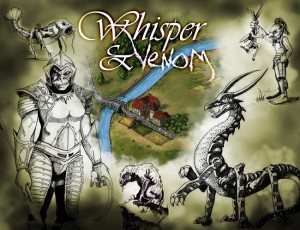 I just got good numbers on different sizes of larger prints of the poster map as one example. The upcoming backer survey will tell me which way backers want to see the map improved, but the map upgrade is the not the first non-mini related stretch goal since the $7000 mark.The numbers worked out that at that point so that I could add mid-range dice (vs. what I will charitably call “Dice”) In addition to the map there will be a side quest adventure designed to be completed in one session that shares the setting but not the focus of the main storyline. There is a reason I am careful about adding content stretch goals and it is cost. If it has text and is included in Whisper & Venom then it will be available in a high-quality printed version. I know many people use PDF files, but I do not (I buy them though, many times out of solidarity with the author).
I just got good numbers on different sizes of larger prints of the poster map as one example. The upcoming backer survey will tell me which way backers want to see the map improved, but the map upgrade is the not the first non-mini related stretch goal since the $7000 mark.The numbers worked out that at that point so that I could add mid-range dice (vs. what I will charitably call “Dice”) In addition to the map there will be a side quest adventure designed to be completed in one session that shares the setting but not the focus of the main storyline. There is a reason I am careful about adding content stretch goals and it is cost. If it has text and is included in Whisper & Venom then it will be available in a high-quality printed version. I know many people use PDF files, but I do not (I buy them though, many times out of solidarity with the author).
Other non-miniature stretch goals that I have done the legwork on already but cannot move forward with yet require a higher level of funding (or higher number of backers at specific levels) before I can commit to them. These include: Laser etched polyhedral d10 dice (I am close on these), monster cards that include new art (once again I am close here as well), a stapled book of the art depicting individual locations in the adventure (like the Tomb of Horrors from 1E) and possibly a map booklet of the adventure locations.
Why so many miniatures when I had all that great stuff? There is a solid reason that is not directly financial. Miniatures, in my mind, are important to have visible early for two reasons. First, the ones I have commissioned are really cool. Not having enough miniatures locked in early is a deal breaker for a large swath of backers. Second, a large percentage of the ones you have seen, even if only teased, are already sculpted or in process. The ones that are unlocked are, with a single exception, finished.
Second the written estimates that guaranteed a certain price point were slower in coming than I expected. No amount of civilized emails or phone calls could make them appear (two of the most important ones took literally daily phone calls for a over a week to even get a response). I know better now, but back around Christmas I never thought three months would not be enough time for a final estimate and guaranteed production dates on everything.
Forced to overestimate some basic costs I had to use what I was able quantify. Although this project is not about profit, for me at least, I have a responsibility to not go broke either. The largest expense in making custom miniatures is the sculpting and that had already been paid for and the remaining production costs of those are well-known enough by me to maintain financial integrity while guaranteeing on-time delivery.
As it stands I have a meeting with a supplier Tuesday and a backer survey is being sent out no later than Monday which both give me a final answer on what is possible and then lock in everything so I can plan accordingly.
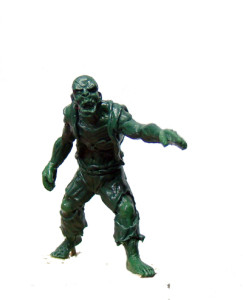 So more of both types are on the way with the bonus of being able to combine some of the ones I had to delay with the already announced minis. Even better for the project, things have shown a consistent positive daily funding rate, gaining either backers or increased pledges while losing very few existing backers, with no signs of changing. Projects do better at the end, especially when they have realistic AND quality stretch goals, which I feel we do.
So more of both types are on the way with the bonus of being able to combine some of the ones I had to delay with the already announced minis. Even better for the project, things have shown a consistent positive daily funding rate, gaining either backers or increased pledges while losing very few existing backers, with no signs of changing. Projects do better at the end, especially when they have realistic AND quality stretch goals, which I feel we do.
I do want to say something regarding the survey that I put out to backers. I am completely serious about letting people who have pledged money having a real say what goes into the final product. I do not investigate (or care) what pledge level backers are at when the survey gets sent out for a vote. So if anyone is even thinking of backing, I encourage them to do so now even if only for $1. Just a buck gets you the link to the feedback and voting that ultimately decides the rewards.
IT: Kickstarter projects have had some large success, large failures, and everything in between. A lot of people are getting more nervous of backing things due to delays on delivery. Why is your project different?
ZG: Easy. It is already paid for by me. Except for actual production expenses everything is that is directly related to the text (art is a big part of this) or to pre-production (Sculpts on the minis for example) has a receipt. In two cases I have funds in the bank explicitly to pay the balance on in process components.
As to fulfillment I have the same answer, if it could be done before I hit the launch button on the project, it was done. If the project ended today it would ship early. Judging by everything I know right now it will wind up in the funding range I expected by next Friday. If that is how it goes the rewards will arrive complete and on time. Barring Felicia Day tweeting every nerd on the internet with a twitter account and begging them to back Whisper & Venom, I am confident I have the ability to ensure on-time delivery. (Felicia, I know you read the Iron Tavern so please tweet away and I will figure something out 🙂 ).
Some things are not possible to plan (health problems for example) but I am willing to assume as much of the risk on this that I can. Simply stated, if you have not received anything at all from me by mail at the end of January of 2014 I will give you a refund. I am asking for a lot from backers simply on faith I can do this. I feel that I owe them at least a commitment to get you what I said I would and a public admission of what will happen should I not follow-through.
I can’t guarantee you will like the product (though my confidence is high in that regard) but you will get something from Lesser Gnome by then. Even if I have to mail a second packages at my expense, you will get at least one significant parcel on time.
I have backed a lot of projects. When I do back them I always select a reward that is shipped. Of the nearly 70 I have backed- two are famously late but I know they are coming, 37 are (or were) a couple of months late and three were out and out fraudulent with one more on the brink of being number four.
I am not going to allow my project to be like any of those, I value my reputation more than I value the level of money we are talking about here.
If anyone is considering backing and they would like to ask me any specific questions I encourage you message me through Kickstarter. I always have time to answer these kinds of questions.
Also, If you have been burned by a Kickstarter project recently but find Whisper & Venom interesting, once again feel free to contact me so you can get a better feel for my judgement and planning.
IT: You have Alyssa Faden working with you on this project. From the previews of the regional map the work looks great. How has it been seeing your world brought to life with her maps?
ZG: It does look great. It will look even better at 42″ x 30″ on a table, or in my case, in a frame.
Exciting, yet also a little humbling. Which is the case with all my visual professionals- Jeff, Lloyd and Alyssa have taken my imagination and made it unbelievably vivid and unquestioningly better.
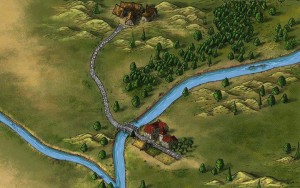 Alyssa’s contribution is a special case for me on a personal level. Fantasy cartography has always been my personal obsession since my first copy of Darlene’s World of Greyhawk Map. As a kid, I loved knowing just enough of a story to have a foundation in a setting and then using that foundation as a basis for imagination. I would spend hours staring at large maps imagining events in the far off corners. Quests, wars, pestilence and much worse would go through my mind as I imagined complete histories and cultures in my head for hours on end.
Alyssa’s contribution is a special case for me on a personal level. Fantasy cartography has always been my personal obsession since my first copy of Darlene’s World of Greyhawk Map. As a kid, I loved knowing just enough of a story to have a foundation in a setting and then using that foundation as a basis for imagination. I would spend hours staring at large maps imagining events in the far off corners. Quests, wars, pestilence and much worse would go through my mind as I imagined complete histories and cultures in my head for hours on end.
To put it another way, places only alluded to in games or novels have always seemed the most interesting. Couple that with a stunning representation of such a places on a map and I still think about those elements 20 years later.
Thus, the poster maps and module gatefold maps are two of the most viscerally nostalgia inducing items for me. I knew what I saw in my mind and thought it was interesting enough visually to justify hiring a professional to get it made. After Alyssa graciously accepted a commission from me, I was nervous giving her anything that would convey what I was thinking in a manner that she could use.
I should never have worried. It was all there in her first draft map I saw. All there but better in both logic and form than what I started with in my own mind. Alyssa made the Whisper Vale very real and very beautiful. If anyone ever needs a map I am confident that you could not get a better piece of art than what get from her.
She has the added virtue of being super cool as well 🙂
IT: Whisper & Venom appears designed for the old-school gamers at its heart, though compatible with any fantasy system. Will the setting be truly systemless or will their be a default system used for stats in the product?
ZG: That has turned out to be a subject where I was surprised a bit by a few gamers with very strong opinions. The answer is long, but I want potential backers to know exactly where I am coming from. Before you read my answer I think it is fair to point out that I like almost every role-playing game I have ever sat in on, so my opinion on the merits of any single system reflect that i.e. I am elastic about some things and not wedded to any single system.
Whisper & Venom is truly a tribute to the feel of older rule-sets and during the early drafts I did indeed use the rules I was most familiar with while preparing the most basic elements of its design. Very early on I intentionally switched gears and wrote it to be rules light- trusting the GM to use whichever mechanics they think is best for their game.
I believe we have one of the smartest, most literate and fastest thinking pool of devotees of any hobby that doesn’t involve differential equations or building robots. Couple that fanbase with the fact that fantasy role-playing has been around longer than I have (which feels like a very long time nowadays 🙂 ) and the result is a pool of game masters that share some pretty robust skills.
Whisper & Venom is compatible with any system in the sense that it has a series of interesting locales, non-player characters, story possibilities, and new opponents that have been depicted by professional artists. The hard part of running a game, in my mind as a GM, is completed already for you in Whisper & Venom. I haven’t meet a GM yet that could honestly say they could not improvise anything into something useful with a modicum of effort. They may prefer not to for a variety of valid reasons, but to make any scenario playable is completely within their abilities.
Whisper & Venom is not something I would feel comfortable recommending for any tournament style play or for use in a role-playing association. There is no final reward, single-solution puzzle or best way to accomplish anything laid out in its pages. Additionally, as it has its own regional setting, it would not have important recognizable elements that make those kinds of things a shared experience.
The adventure portion was designed with older systems in mind simply because those are the style with which I am most familiar. I am confident it will work just as well using any system with minimal adjustments. Even stripped of any rule mechanics it still provides maps, figurines, setting information and non-player characters with short written histories.
The vast majority of you truly do not NEED system specific rule guidelines in any adventure product- I really believe that. I did, however, intentionally design it as a low to mid-level adventure to minimize the complications involved with high level spells or feats.
That being said, while I did the bulk of the writing I wrote it using modern simulacrum rules- specifically Labyrinth Lord and OSRIC. The playtest sessions used the same. Combat tests were done with 3e and DCC as well.
When I lock in the final stats in July after backer content is evaluated and included; the numbers I will include and reference will be for Labyrinth Lord. I do this simply because I know the rules can be downloaded for free.
A conversion section, at the very least, will be included. If I am at a slightly higher total funding level a week from today than Kicktraq is showing I can expect, I do more than just Conversion tables. I am 100% prepared to invest a significant amount of money to hire an experienced, published freelance professional to do a total overhaul of all the encounters in Whisper & Venom for Pathfinder.
IT: Tell us a little about your gaming history? How did you get your start in gaming? What games are you playing today?
ZG: My age put me dead center in the peak years of TSR’s pop-culture popularity.
My Mom bought me the Moldvay Basic D&D Box Set from a Sears catalog. Followed by a great deal of games and accessories from that era. I didn’t own too many different rule sets, especially after I settled into 1st Edition AD&D, but amongst my friends we had a huge number of classic RPGs. One of my true highlights was when I got a week of detention in grade school for carrying a copy of Eldritch Wizardry on the playground; I was incredulous about it but it was during the time when D&D was dangerous. Right-thinking moms in our town tried to curtail us from playing but we played all the time.
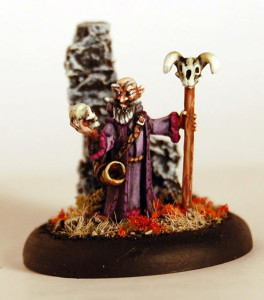 By the time I was in 7th grade we had moved to a smaller town and there were fewer players. Which was bad, but the worst was having no game store. So my rate of acquisitions was slowed considerably. What I did have though was time and all the core rule books which I read like novels. I am a Tolkien fanatic though and we did play a great deal of MERP.
By the time I was in 7th grade we had moved to a smaller town and there were fewer players. Which was bad, but the worst was having no game store. So my rate of acquisitions was slowed considerably. What I did have though was time and all the core rule books which I read like novels. I am a Tolkien fanatic though and we did play a great deal of MERP.
In High School we branched out to other game genres. Traveller was popular for awhile, as was Twilight: 2000. War games were a fascination of mine, but nobody would even try to play those with me. Even now at conventions specifically meant for games from that era I never see Star Fleet Battles at a table. The closest I got in that regard back then was Battletech.
From there it was PC games pretty exclusively. No FPS games; instead it was games like Bungie’s Myth or X-Wing vs. Tie Fighter. Not finishing Planescape: Torment is a black mark on my otherwise solid nerd resume.
I tried to play Games Workshop games but I was too poor. Everyone who was playing was ten years younger and could field armies worth as much as my car. So I quit and haven’t been much of a fan of their stuff since (except Blood Bowl).
Then I got a career in politics and lost my mojo during the whole d20 era. I bought the 3e books and played a few times but the nature of my job isolated from like-minded nerds. The only game my co-workers played was golf and the attribute that mattered to them was charisma.
Then WoW was released and I thought “I have a couple of free hours a week maybe that would be fun”… 3 years later I logged off.
Now I mostly play RPGs at conventions but I make a point to try everything offered that I hadn’t played before. My wife thinks its funny but people do ask me very pointed questions about ruleset preferences. The answer is that if I was to choose now from the actual older rule-sets I would lean toward the Moldvay/Cook BX Sets or the amazing BECMI sets by Frank Mentzer.
I have played a ton of newer simulacrum varieties and updated FRPG sets at conventions or one off get togethers including: Labyrinth Lord; OSRIC; Adventurer, Conqueror, King; Dungeon Crawl Classics; Astonishing Swordsman & Sorcerers of Hyperborea; Swords & Wizardry and others I am sure I have forgotten. Dungeon Crawl Classics is my current favorite of these types of games but it is also the last one I played. When I play another round of AS&SH I will probably decide that one is my favorite until I move on.
I have played but I am no expert with: Pathfinder, HackMaster and the newest editions of the worlds most popular fantasy role-playing game. I like them very much and I own them all but have yet to give them their due. Of those systems, I am the most interested in Pathfinder.
My most recent gaming achievement was becoming the Circus Maximus champion at the North Texas Role-Playing Game Convention a few weeks ago. The trophy just arrived and sits where my wedding pictures used to.
So yeah, I like games.
IT: Gnomes, gnomes, gnomes. Why gnomes and why Thopas?
ZG: I will turn the tables on you on this question.
Cars, Cars, Cars. Why cars and why Ferrari? 🙂
Honestly, it because of my life long good friend John Hammerle. He is the other gnome in Lesser Gnome (he finally found a use for graduate school literature classes and has edited most every sentence of Whisper & Venom). As kids he started playing a gnome illusionist. As this is a family friendly website I will simply say he played that illusionist in a style unbefitting a civilized person. Foul, greedy, secretive and incredibly lusty- he was John’s complete opposite.
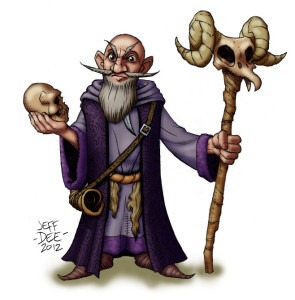 He was also a party favorite that became an NPC who popped up in all kinds of games. Finally he had a second career in World of Warcraft that to this day seems surreal. It was so bizarre seeing other people’s reaction to him. He would get the most unusual private messages that ran the gamut from sexual to sinister, all while being played by a guy who doesn’t even swear. The same guy who hates telephones, has no use for twitter, prefers books to people and only goes to social functions when his wife makes him.
He was also a party favorite that became an NPC who popped up in all kinds of games. Finally he had a second career in World of Warcraft that to this day seems surreal. It was so bizarre seeing other people’s reaction to him. He would get the most unusual private messages that ran the gamut from sexual to sinister, all while being played by a guy who doesn’t even swear. The same guy who hates telephones, has no use for twitter, prefers books to people and only goes to social functions when his wife makes him.
So when I started writing Whisper & Venom, as a way to pass some downtime in the hospital, I wanted to add an NPC that would be memorable. However, I did not want one who was central to the story or whose actions were necessary for any part of its enjoyment. Most importantly I did not want an NPC that had a role as a moral compass or benevolent sage that nudged players in certain directions.
The only moral Thopas has is amoral.
Go with what you know 🙂
Wrap Up
The Iron Tavern wants to thank Zach for taking the time for this interview. If the Whisper & Venom project looks interesting to you, stop by their Kickstarter and check out their various patronage levels. There is still eight days left as of this post!
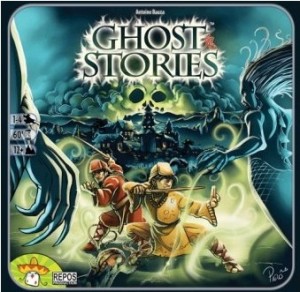 I have always been a fan of horror in my games. In fact the games that I remember the most have been those that I have centred around a horror fantasy concept. But not just any horror. If you are after a horror game that will make the players sweat bullets and jump at your every word then you are trying to create a setting that is the hardest to pull off. It is a prize I have tried for many times and failed each time. But if you want to run a game which will leave the players at the end with open mouths because of the horror story that has just been told read on.
I have always been a fan of horror in my games. In fact the games that I remember the most have been those that I have centred around a horror fantasy concept. But not just any horror. If you are after a horror game that will make the players sweat bullets and jump at your every word then you are trying to create a setting that is the hardest to pull off. It is a prize I have tried for many times and failed each time. But if you want to run a game which will leave the players at the end with open mouths because of the horror story that has just been told read on.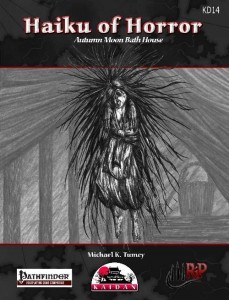 This gives you a few basic ideas that you can turn into your own games or you can build your own from these ideas. At the heart of them all is one concept and that is innocent corrupted. If you want to look at a great (and cheap) module that follows this style designed for Pathfinder look at the recent release Haiku of Horror for inspiration!
This gives you a few basic ideas that you can turn into your own games or you can build your own from these ideas. At the heart of them all is one concept and that is innocent corrupted. If you want to look at a great (and cheap) module that follows this style designed for Pathfinder look at the recent release Haiku of Horror for inspiration!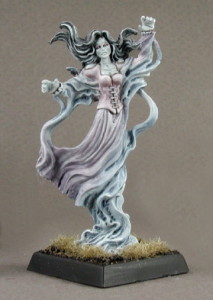 The climax of an adventure should not be a battle with the spirit or creature. It certainly should happen though. What needs to happen is the players have to finish what they have started or the problem continues. With a spirit, they just continue to show up! You have to bring to light the circumstances that lead to the malevolent spirit coming into being. Remove the body from the hidden basement and have the parents arrested (Lawful Good) or seal them into the same room (Neutral!) should do it. One way or another the players need to continue to pursue the story until its end. It is when they put all the pieces together that you will get the response you are after. That wow factor from them as they complete their investigation and they marvel at the evil that can be done to even the most innocent amongst us.
The climax of an adventure should not be a battle with the spirit or creature. It certainly should happen though. What needs to happen is the players have to finish what they have started or the problem continues. With a spirit, they just continue to show up! You have to bring to light the circumstances that lead to the malevolent spirit coming into being. Remove the body from the hidden basement and have the parents arrested (Lawful Good) or seal them into the same room (Neutral!) should do it. One way or another the players need to continue to pursue the story until its end. It is when they put all the pieces together that you will get the response you are after. That wow factor from them as they complete their investigation and they marvel at the evil that can be done to even the most innocent amongst us.

